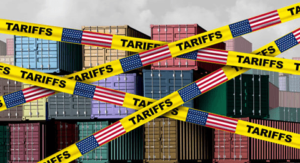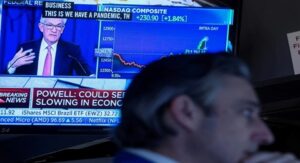
The Cost of De-Dollarization: Implications for Global Trade and Finance
The cost of De-dollarization looms large, echoing historical shifts in global economic power. From its post-WWII zenith to today’s waning influence, the dollar’s journey underscores intertwined geopolitics and finance. While its dominance dwindles, no single alternative emerges, hinting at a fragmented, ‘multi-currency’ future. Yet, amidst this transition, risks abound.
Dollar weaponization threatens global stability, while trade imbalances loom without its anchoring role. The demise of dollar hegemony jeopardizes not just financial systems, but the very structure of global commerce. As nations navigate this landscape, preserving multilateral trade becomes paramount, necessitating both prudence in financial policy and broader socio-economic reforms for a sustainable global future.
The Real Cost of De-Dollarization
At the end of World War II, the global economic landscape underwent a seismic shift. The United States emerged as the preeminent economic powerhouse, backed by significant gold reserves and accounting for over half of the world’s economic output.
With the United Kingdom’s financial decline, the dollar, pegged to gold at $35 an ounce, swiftly became the linchpin of global trade and finance.
However, the dynamics have evolved since then, raising concerns about the ramifications of de-dollarization, including the potential cost of De-dollarization.
Table of Contents
1. Historical Context
Following World War II, the United States emerged as a paramount force in the global economy, cementing the dollar as the premier reserve currency worldwide. The demise of the British pound highlighted the dollar’s supremacy, bolstered by the Bretton Woods framework and the formation of the International Monetary Fund (IMF). This era marked a pivotal shift, with the US wielding unparalleled economic influence, shaping international trade and finance.
The Bretton Woods system provided stability, while the IMF acted as a guardian of financial order, collectively fostering an environment where the dollar reigned supreme, symbolizing American economic hegemony on the global stage. However, the cost of De-dollarization is now becoming a significant concern, as countries seek to reduce their dependency on the dollar amidst geopolitical shifts and the rise of alternative currencies.
Read More: BRICS Blockchain-Based Payment System: A New Dawn in Global Finance
2. Current Dollar Dominance
Despite the US comprising just a quarter of global output, the dollar remains dominant, engaging in nearly 90% of foreign-exchange transactions. Nonetheless, its portion of central-bank foreign-exchange reserves has dwindled, hinting at possible alterations in global economic dynamics and highlighting the cost of De-dollarization.
This paradox underscores the enduring power of the dollar in international transactions while suggesting a changing landscape where other currencies may gain prominence.
The dollar’s resilience in foreign-exchange markets contrasts with its declining presence in central-bank reserves, pointing towards a nuanced evolution in global economic relationships, where traditional powerhouses may cede ground to emerging players, shaping the future trajectory of the international monetary system.
Read More: Europe’s Economic Performance in 2024: Insights & Forecasts
3. Threats to Dollar Dominance
The dominance of the dollar faces its most formidable challenge not from external currencies but from domestic dilemmas within the US. Political impasse, vividly demonstrated by recurrent clashes over the debt ceiling, and the strategic manipulation of sanctions, diminish confidence in the dollar’s resilience and dependability. As these internal rifts persist, they chip away at the foundation of the dollar’s hegemony, casting doubts on its long-term viability as the global reserve currency.
Consequently, sustaining its supremacy demands addressing these internal fissures, fortifying both trust and stability in the dollar’s reign amidst a complex and evolving global economic situation. Moreover, the cost of De-dollarization looms as an additional concern, underscoring the imperative for the US to resolve its internal challenges efficiently to maintain the dollar’s status as the predominant global currency.
Read More: Geopolitics of Economic Development in the Middle East
4. Limited Viable Alternatives
The euro and Chinese renminbi are frequently considered alternatives to the dominant currencies, yet both encounter formidable obstacles. The euro contends with internal market fragmentation and uncertainties surrounding the EU’s enduring stability. Meanwhile, the renminbi struggles with credibility issues stemming from China’s stringent regulations and relatively immature financial markets.
Despite aspirations for diversification, these currencies confront significant challenges that inhibit their widespread adoption on the global stage. The cost of De-dollarization, including potential disruptions to existing financial infrastructures and international trade relations, further complicates the transition to alternative currencies.
Read More: The Economics of War: A Comprehensive Analysis in 7 Key Points
5. Implications of De-Dollarization
The potential decline of the dollar’s hegemony may propel a shift towards a “multi-currency” paradigm, unsettling conventional trade frameworks. Nations might revert to barter systems or impose trade barriers, imperiling the efficacy of global trade reliant on seamless exchanges of goods and services. This transition could introduce complexities, as businesses navigate diverse currency valuations and fluctuating exchange rates.
The cost of De-dollarization consequently becomes a significant factor, potentially amplifying transactional friction and increasing operational expenses. Consequently, the once-unified landscape of international commerce may fragment, necessitating adaptive strategies to mitigate disruptions and sustain economic interconnectedness amidst a diversified currency ecosystem.
6. Preserving Global Trade Stability
Ensuring the stability of global trade hinges on upholding the dollar’s trustworthiness. This entails confronting domestic hurdles in the US like political gridlock and overreliance on financial sanctions. Simultaneously, fortifying social safety nets becomes imperative to cushion against globalization’s negative impacts on local communities. However, amidst these efforts, it’s crucial to consider the cost of De-dollarization, as shifting away from the dollar as the primary reserve currency could introduce significant economic challenges.
This delicate balance demands proactive measures to alleviate internal strains while fortifying resilience to external economic forces. By navigating these challenges adeptly, the US can foster both international trade stability and domestic prosperity, laying the groundwork for a more equitable and sustainable global economic perspective.
Read More: Geopolitical Tensions and Economic Projections in 2024
Bottom Line
Navigating the complexities of de-dollarization, a complex economic shift, demands careful consideration due to its profound ramifications, including the cost of De-dollarization. Despite the potential for the dollar’s dominance to wane, finding credible substitutes poses a significant challenge, highlighting the intricate nature of restructuring the global financial landscape.
Amidst these complexities, stakeholders must prioritize maintaining stability and efficiency in global trade, recognizing it as a pivotal goal amidst evolving economic frameworks. Balancing these objectives requires a nuanced approach, acknowledging the multifaceted dynamics at play and the imperative of adapting to changing paradigms.





